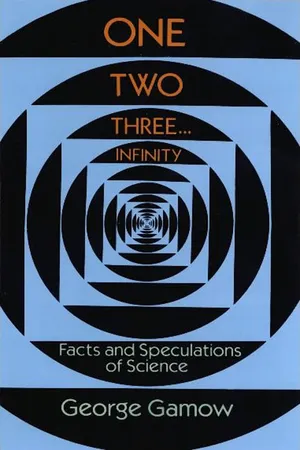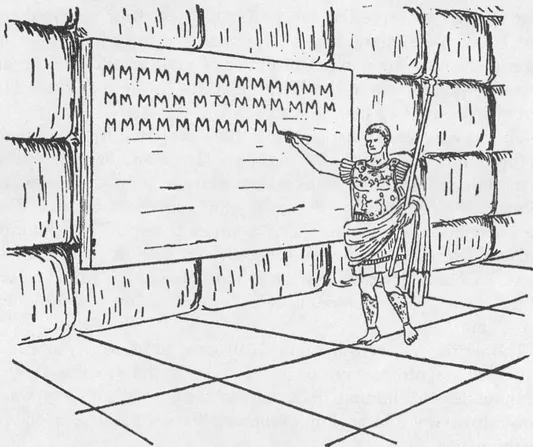1. HOW HIGH CAN YOU COUNT?
THERE is a story about two Hungarian aristocrats who decided to play a game in which the one who calls the largest number wins.
“Well,” said one of them, “you name your number first.”
After a few minutes of hard mental work the second aristocrat finally named the largest number he could think of.
“Three,” he said.
Now it was the turn of the first one to do the thinking, but after a quarter of an hour he finally gave up.
“You’ve won,” he agreed.
Of course these two Hungarian aristocrats do not represent a very high degree of intelligence2 and this story is probably just a malicious slander, but such a conversation might actually have taken place if the two men had been, not Hungarians, but Hottentots. We have it indeed on the authority of African explorers that many Hottentot tribes do not have in their vocabulary the names for numbers larger than three. Ask a native down there how many sons he has or how many enemies he has slain, and if the number is more than three he will answer “many.” Thus in the Hottentot country in the art of counting fierce warriors would be beaten by an American child of kindergarten age who could boast the ability to count up to ten!
Nowadays we are quite accustomed to the idea that we can write as big a number as we please—whether it is to represent war expenditures in cents, or stellar distances in inches—by simply setting down a sufficient number of zeros on the right side of some figure. You can put in zeros until your hand gets tired, and before you know it you will have a number larger than even the total number of atoms in the universe,3 which, incidentally, is 300,000,000,000,000,000,000,000,000,000,000,000,000,000,000,000,-000, 000,000,000,000,000,000,000,000.
Or you may write it in this shorter form: 3.1074.
Here the little number74 above and to the right of 10 indicates that there must be that many zeros written out, or, in other words, 3 must be multiplied by 10 seventy-four times.
But this “arithmetic-made-easy” system was not known in ancient times. In fact it was invented less than two thousand years ago by some unknown Indian mathematician. Before his great discovery—and it was a great discovery, although we usually do not realize it—numbers were written by using a special symbol for each of what we now call decimal units, and repeating this symbol as many times as there were units. For example the number 8732 was written by ancient Egyptians:
whereas a clerk in Caesar’s office would have represented it in this form:
The latter notations must be familiar to you, since Roman numerals are still used sometimes—to indicate the volumes or chapters of a book, or to give the date of a historical event on a pompous memorial tablet. Since, however, the needs of ancient accounting did not exceed the numbers of a few thousands, the symbols for higher decimal units were nonexistent, and an ancient Roman, no matter how well trained in arithmetic, would have been extremely embarrassed if he had been asked to write “one million.” The best he could have done to comply with the request, would have been to write one thousand M’s in succession, which would have taken many hours of hard work (Figure 1).
For the ancients, very large numbers such as those of the stars in the sky, the fish in the sea, or grains of sand on the beach were “incalculable,” just as for a Hottentot “five” is incalculable, and becomes simply “many”!
It took the great brain of Archimedes, a celebrated scientist of the third century B.C., to show that it is possible to write really big numbers. In his treatise The Psammites, or Sand Reckoner, Archimedes says:
FIGURE 1
An ancient Roman, resembling Augustus Caesar, tries to write “one million” in Roman numerals. All available space on the wall-board hardly suffices to write “a hundred thousand.”
“There are some who think that the number of sand grains is infinite in multitude; and I mean by sand not only that which exists about Syracuse and the rest of Sicily, but all the grains of sand which may be found in all the regions of the Earth, whether inhabited or uninhabited. Again there are some who, without regarding the number as infinite, yet think that no number can be named which is great enough to exceed that which would designate the number of the Earth’s grains of sand. And it is clear that those who hold this view, if they imagined a mass made up of sand in other respects as large as the mass of the Earth, including in it all the seas and all the hollows of the Earth filled up to the height of the highest mountains, would be still more certain that no number could be expressed which would be larger than that needed to represent the grains of sand thus accumulated. But I will try to show that of the numbers named by me some exceed not only the number of grains of sand which would make a mass equal in size to the Earth filled up in the way described, but even equal to a mass the size of the Universe.”
The way to write very large numbers proposed by Archimedes in this famous work is similar to the way large numbers are written in modern science. He begins with the largest number that existed in ancient Greek arithmetic: a “myriad,” or ten thousand. Then he introduced a new number, “a myriad myriad” (a hundred million), which he called “an octade” or a “unit of the second class.” “Octade octades” (or ten million billions) is called a “unit of the third class,” “octade, octade, octades” a “unit of the fourth class,” etc.
The writing of large numbers may seem too trivial a matter to which to devote several pages of a book, but in the time of Archimedes the finding of a way to write big numbers was a great discovery and an important step forward in the science of mathematics.
To calculate the number representing the grains of sand necessary to fill up the entire universe, Archimedes had to know how big the universe was. In his time it was believed that the universe was enclosed by a crystal sphere to which the fixed stars were attached, and his famous contemporary Aristarchus of Samos, who was an astronomer, estimated the distance from the earth to the periphery of that celestial sphere as 10,000,000,000 stadia or about 1,000,000,000 miles.4
Comparing the size of that sphere with the size of a grain of sand, Archimedes completed a series of calculations that would give a highschool boy nightmares, and finally arrived at this conclusion:
“It is evident that the number of grains of sand that could be contained in a space as large as that bounded by the stellar sphere as estimated by Aristarchus, is not greater than one thousand myriads of units of the eighth class.”5
It may be noticed here that Archimedes’ estimate of the radius of the universe was rather less than that of modern scientists. The distance of one billion miles reaches only slightly beyond the planet Saturn of our solar system. As we shall see later the universe has now been explored with telescopes to the distance of 5,000,000,000,000,000,000,000 miles, so that the number of sand grains necessary to fill up all the visible universe would be over:
10100 (that is, 1 and 100 zeros)
This is of course much larger than the total number of atoms in the universe, 3·1074, as stated at the beginning of this chapter, but we must not forget that the universe is not packed with atoms; in fact there is on the average only about 1 atom per cubic meter of space.
But it isn’t at all necessary to do such drastic things as packing the entire universe with sand in order to get really large numbers. In fact they very often pop up in what may seem at first sight a very simple problem, in which you would never expect to find any number larger than a few thousands.
One victim of overwhelming numbers was King Shirham of India, who, according to an old legend, wanted to reward his grand vizier Sissa Ben Dahir for inventing and presenting to him the game of chess. The desires of the clever vizier seemed very modest. “Majesty,” he said kneeling in front of the king, “give me a grain of wheat to put on the first square of this chessboard, and two grains to put on the second square, and four grains to...



